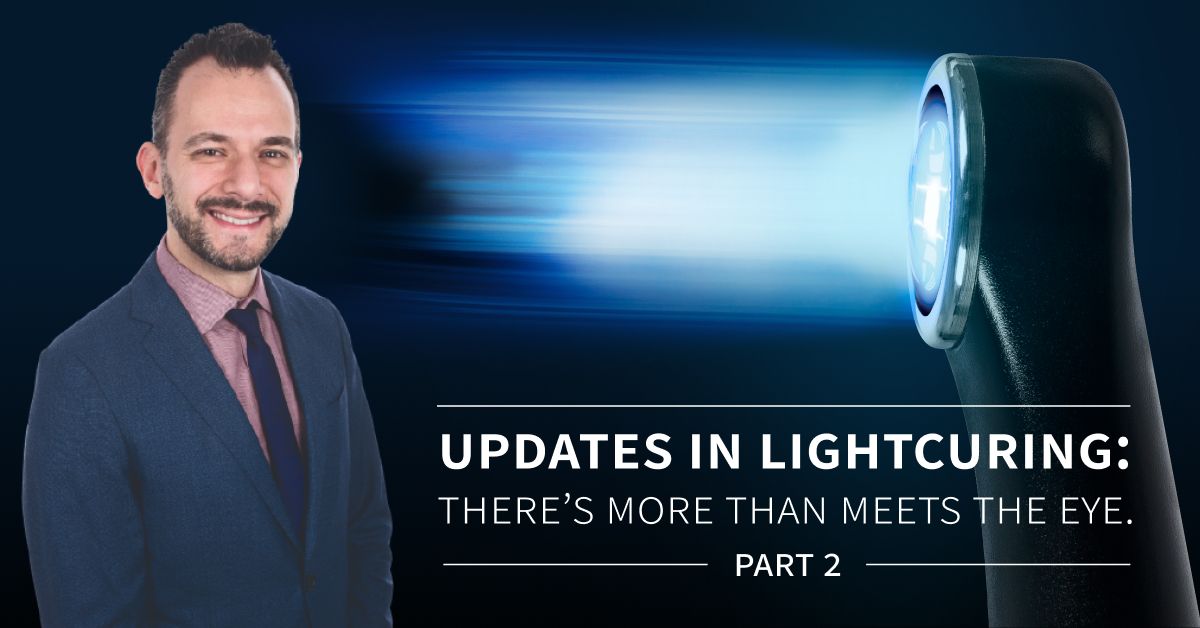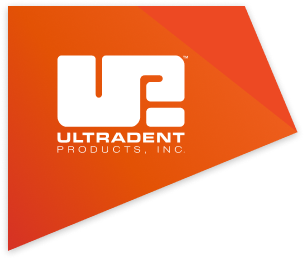Rafael S. Beolchi(a), DDS, MSc
Carlos Shimokawa(b), DDS, MSc, PhD
Bruno Pelissier(c), MCU-PhD
(a) University of São Paulo, School of Dentistry, São Paulo, São Paulo, Brazil.
(b) University of São Paulo, School of Dentistry, São Paulo, São Paulo, Brazil.
(c) MCU-PH, Dentisterie Restauratrice, service OCE. UFR d’Odontologie de Montpellier I. 545 Avenue du Pr JL Viala. 34193 Montpellier Cedex 5. Laboratoire EA 4203
Different photoinitiators requires different wavelengths
Until today, there are still many misunderstandings and also frustrations regarding the real compatibility between lightcuring devices and restorative lightcurable materials, and that’s why knowing the wavelength of the emitted light is so essential.
For many dentists in the late 1980s and during the 1990s, the quartz-tungsten halogen lamps (QTH) were the more popular blue light source, and were used to sensitize the camphorquinone photoinitiator system, a class of materials that absorbs visible light in the range of 468 nm13. QTH lamps have a special glass filter that absorbed heat and also a light filter which allowed the passage of a broad spectrum of blue light between 400 and 550 nm14, more than enough to activate camphorquinone.
During the late 1990s, dental bleaching became a successful treatment. Thus, new composite colors were needed, colors that could match the lighter, high-luminosity colors of bleached teeth. Using only camphorquinone as a photoinitiator hindered that possibility, since its bright yellow color had a significant influence on the composite’s final color2.
The dental industry then started looking for options, and materials with a different light absorption peak were brought back. These photoinitiators belong to a class of materials that degrades in two radicals without the necessity of a co-initiator, and despite also being yellowish, they have the advantage of bleaching after curing15. They were used in the early years of lightcurable composites, and needed ultraviolet (UV) energy (around 365 nm)16, 17.
When combined with camphorquinone, these materials present a synergistic effect, allowing for a smaller concentration of the latter and reducing the residual yellow color of the restoration after photoactivation18, while still achieving a very good, sometimes improved cure19.
Another advantage of the combined use of those new photoinitiators, like TPO, APO or BAPO is the fact that there’s an increase in color stability of the composite restorations, compared to others that use only camphorquinone, without compromising the physical and chemical properties of the restoration20, 21.
Because these new photoinitiators are currently being widely used, not only in composites, but also in other kinds of lightcurable materials such as resin cements, clinicians should know if their lightcuring device is capable of emitting a spectrum of light powerful and broad enough to cure all kinds of composites.
In order to properly understand that, a little history is necessary: the first LED devices for dental use were launched in the early 2000s. LEDs are chips manufactured with a semiconductor material with impurities, thus creating a p-n junction where electric current flows from the anode (p junction) to the cathode (n junction). The wavelength of the light emitted, and thus its color, depends on the band gap energy of the materials forming the p-n junction22.
Blue emissions were developed using semiconductor substrates of Indium Gallium Nitride (InGaN)22. The emitted light is not completely monochromatic, as in the case of lasers, but the bandwidth spectrum is relatively narrow, especially if compared with the broad spectrum emitted by other lights, especially the halogen lamps. In other words, the spectrum of emitted light matched only the absorption peak of camphorquinone, insufficient to adequately cure more modern composites and their new alternative photoinitiators23.
That situation began to change in the beginning of the 21st century, when a new technology allowed the manufacturing of a single chip with multiple LEDs, greatly increasing light emission, and allowing the fabrication of LED chips that were capable of emitting more than one wavelength. These new devices were also able to produce a larger amount of light, allowing for shorter curing times for the resin-based composite restorations24.
One of the first of this kind was UltraLume 5 (Ultradent Products Inc.), with a central 5W blue LED (with a wavelength around 465 nm) surrounded by four other low-intensity lights (with wavelengths around 400 nm).
Figures 7a, depicts the chipset of the LEDs for ValoTM. Figure 7b shows the same LEDs, now lit, where it is possible to note the different wavelengths emitted. The two identical LEDs produce blue light in the range of 465 nm, the upper left produces light in the range of 405 nm, and finally, the bottom right, in the range of 445 nm. Figure 7c depicts the lamp’s projected light footprint.
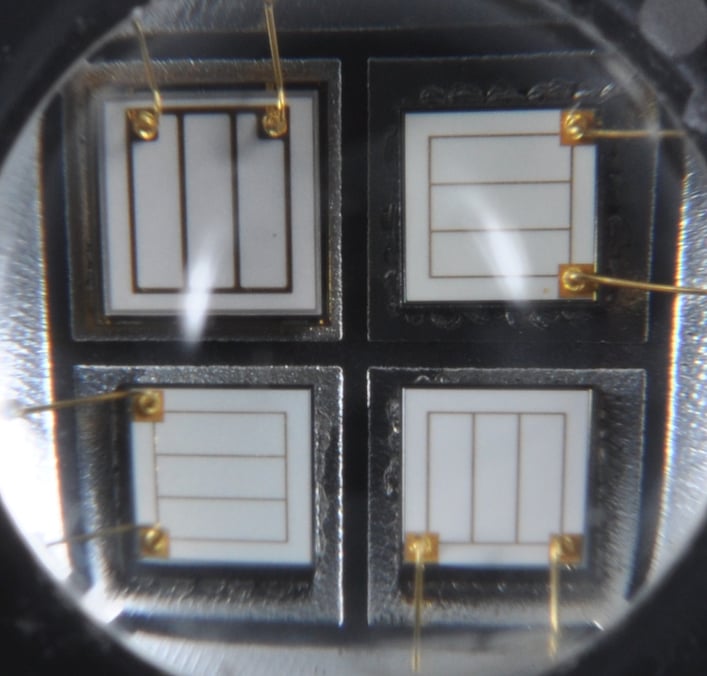 Figure 7a
Figure 7a
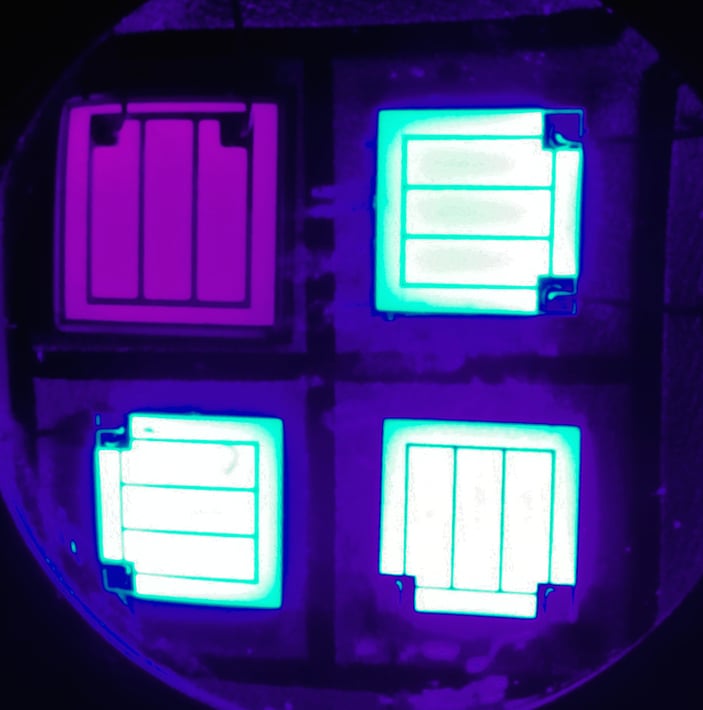 Figure 7b
Figure 7b
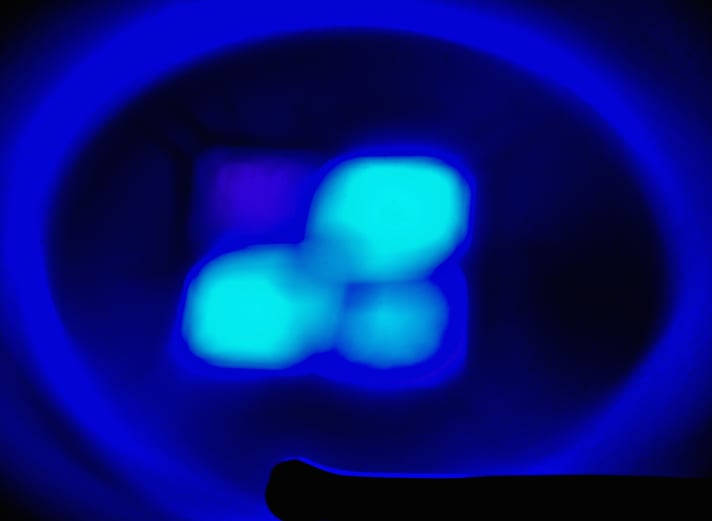
Figure 7c
Figure 7: VALO LEDs off (Figure 7a) and lit (Figure 7b), and the device’s footprint projected on a wall (Figure 7c).
Figure 8 presents the spectral analysis of the emitted light of VALO. Besides the blue light, in the range of 465nm, it also produces light in shorter wavelengths, thus being able to sensitize the new alternate photoinitiators.
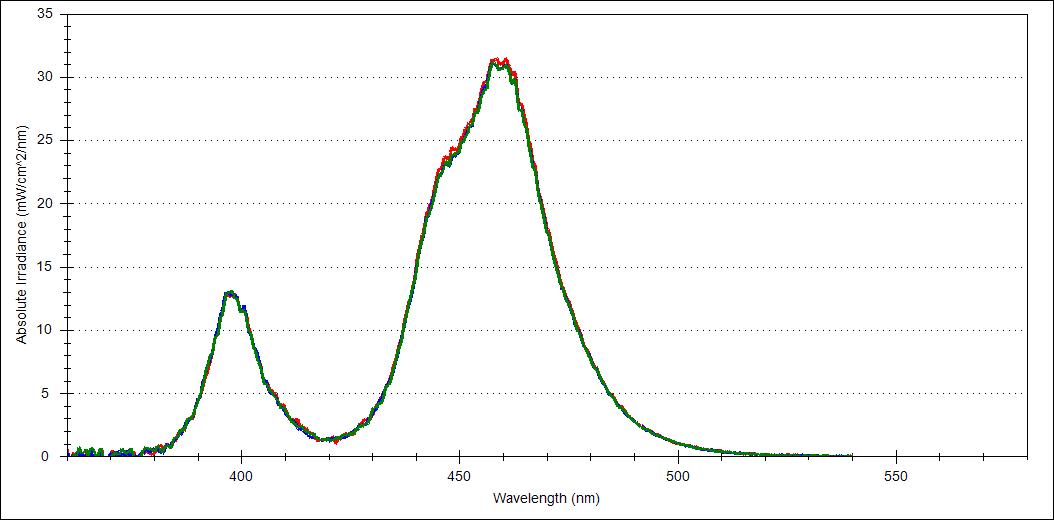
Figure 8: Spectral analysis of the emitted light of VALO.
To be continued...
References
1 Price, R.B.; McLeod, M. E.; Felix, C. M. Quantifying Light Energy Delivered to a Class I Restoration J Can Dent Assoc 2010; 76:a23
2 Price R.B., Felix C.A. Effect of delivering light in specific narrow bandwidths from 394 to 515nm on the microhardness of resin composites Dental Materials 2009 25(7) 899- 908
3 Rueggeberg FA. State-of-the-art: dental lightcuring - a review. Dent Mater. 2011 Jan;27(1):39-52. Review.
4 Hyun HK, Christoferson CK, Pfeifer CS, Felix C, Ferracane JL. Effect of shade, opacity and layer thickness on light transmission through a nano-hybrid dental composite during curing. J Esthet Restor Dent. 2017 Sep;29(5):362-367. doi: 10.1111/jerd.12311. Epub 2017 Jun 19.
5 Halvorson RH, Erickson RL, Davidson CL. Energy dependent polymerization of resin-based composite. Dent Mater. 2002 Sep;18(6):463-9.
6 Koran P, Kürschner R. Effect of sequential versus continuous irradiation of a lightcured resin composite on shrinkage, viscosity, adhesion, and degree of polymerization. Am J Dent 10, 17–22 (1998)
7 Fróes-Salgado NR, Francci C, Kawano Y. Influência do modo de fotoativação e da distância de irradiação no grau de conversão de um compósito. Perspect Oral Sci 2009 Ago; 1(1):11-17.
8 Kelsey W, Blankenau RJ, Powell GL, Barkmeyer W, Stormberg E. Power and time requirements for using the argon laser to polymerize composite resins. J Clin Laser Med Surg 1992;10:273–8.
9 Benetti AR, Asmussen E, Peutzfeldt A. Influence of curing rate of resin composite on the bond strength to dentin. Oper Dent. 2007 Mar-Apr;32(2):144-8.
10 Pfeifer CS, Ferracane JL, Sakaguchi RL, Braga RR. Photoinitiator content in restorative composites: influence on degree of conversion, reaction kinetics, volumetric shrinkage and polymerization stress. Am J Dent. 2009 Aug;22(4):206-10.
11 Rode KM, Kawano Y, Turbino ML. Evaluation of curing light distance on resin composite microhardness and polymerization. Oper Dent. 2007 Nov-Dec;32(6):571-8.
12 Beolchi RS, Garófalo JC, Forti W, Palo RM. O seu fotopolimerizador está preparado para os novos materiais? Revista APCD de Estética 2013;v.1(3) p. 240-250.
13 Mills RW, Jandt KD, Ashworth SH. Dental composite depth of cure with halogen and blue light emitting diode technology. Br Dent J. 1999 Apr 24;186(8):388-91.
14 Rueggeberg F. Contemporary issues in lightcuring. Comp Cont Educ Dent 1999;20(Suppl. 25):S4–15.
15 Rutsch W, Dietliker D, Leppard D, Kohler M, Misev L, Kolczak U. Recent developments in photoinitiators. Prog Org Coat 1996;27:227–39.
16 Lienhard O,inventor. Canrad Precision Industries,Inc., assignee: instrument for transmitting ultra-violet radiation to a limited area. United States Patent 3,712,984; 1973.
17 Neumann MG, Miranda Jr WG, Schmitt CC, Rueggeberg FA, Correa IC. Molar extinction coefficients and the photon absorption efficiency of dental photoinitiators and light curing units. J Dent 2005;33:525–32.
18 Park YJ, Chae KH, Rawls HR. Development of a new photoinitiation system for dental light-cure composite resins. Dent Mater 1999;15:120–7.
19 Palin WM, Leprince JG, Hadis MA Shining a light on high volume photocurable materials. Dent Mater. 2018 May;34(5):695-710.
20 Albuquerque PP, Moreira AD, Moraes RR, Cavalcante LM, Schneider LF. Color stability, conversion, water sorption and solubility of dental composites formulated with different photoinitiator systems. J. Dent. 2012 Dec 8. pii: S0300-5712(12)00322-3.
21 Brandt WC, Gomes-Silva C, Frollini E, Souza-Junior, EJ, Sinhoreti, MAC. Dynamic mechanical thermal analysis of composite resins with CQ and PPD as photo-initiators photoactivated by QTH and LED units. J Mech Behav Biomed Mater 24 (2013) 21–29
22 Krames M. Light-emitting diode technology for solid-state lighting. In: National academy of engineering: US frontiers of engineering symposium. 2009.
23 Uhl A, Sigusch BW, Jandt KD. Second generation LEDs for the polymerization of oral biomaterials. Dent Mater 2004;20:80–7
24 Amaral CM, Peris AR, Ambrosano GM, Pimenta LA. Microleakage and gap formation of resin composite restorations polymerized with different techniques. Am J Dent 2004;17:156–60
25 Shimokawa CA, Turbino ML, Harlow JE, Price HL, Price RB. Light output from six battery operated dental curing lights.
Mater Sci Eng C Mater Biol Appl. 2016 Dec 1;69:1036-42. doi: 10.1016/j.msec.2016.07.033. Epub 2016 Jul 21.
26 Shimokawa CAK, Turbino ML, Giannini M, Braga RR, Price RB. Effect of light curing units on the polymerization of bulk fill resin-based composites Dent Mater. 2018 Aug;34(8):1211-1221. doi: 10.1016/j.dental.2018.05.002. Epub 2018 May 22.


